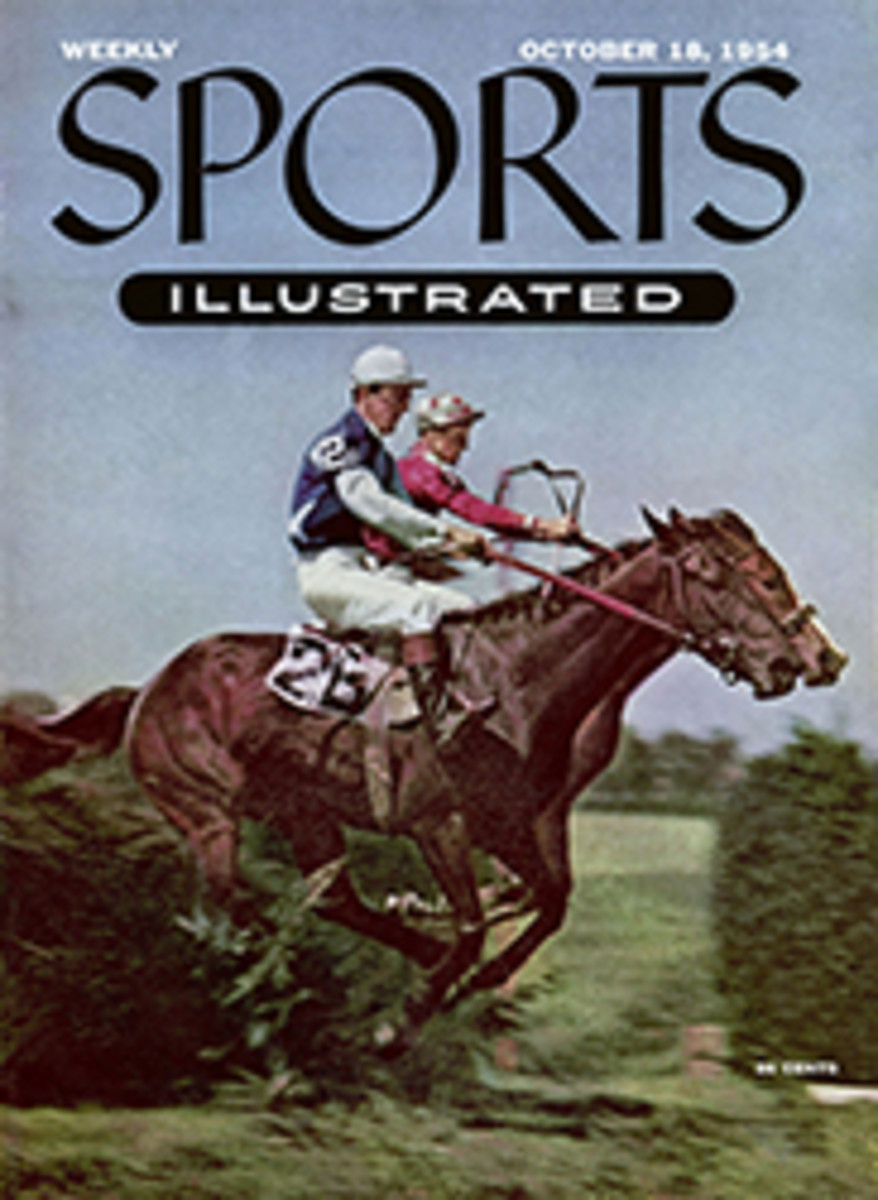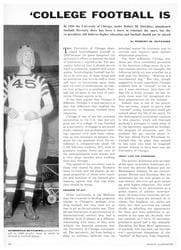
A Rare Find: GORDON'S FLY BOX
Anglers this year celebrate the 100th anniversary of the birth of the immortal Theodore Gordon, father of the dry fly in the U.S., and the outstanding personality in modern American trout fishing. Gordon himself once said: "All fishing cranks enjoy looking over a good angling kit, rods, flies and tackles." In commemoration of the occasion SPORTS ILLUSTRATED presents this portfolio of treasured Gordoniana: a photograph of Gordon as a young man, one of his trout rods, a set of dry flies that he received from the great English angling writer, Frederic M. Halford, and what is believed to be the only remaining fly box owned by Gordon, just recently come to light (next page).
The Halford flies are more than casual memorabilia. They are perhaps the most important single document in American fly fishing. They were clipped into a letter which carried these prophetic last words: "...kindly let me know the results of your experiments." By the time Gordon died in 1915 the results of his experiments were known to many fishermen and today they are in common practice wherever trout are sought. The letter established, with rare accuracy for piscatorial matters, the precise date on which modern American fly fishing began: Feb. 22, 1890.
Fly fishing has but two eras: that extending from antiquity to less than 100 years ago, during which all flies were "wet" and usually fished sunk; that extending from the late 19th Century to the present, during which the "dry" or floating fly was created and developed.
It is curious that in retrospect an invention often appears so simple and obvious. We take the dry fly for granted. Yet it took the combined efforts of countless anglers over centuries of fishing the wet fly dry to produce this unique little creation. The movement culminated in England in the 1880s in the written works of Frederic Halford, and no sooner did these writings arrive in New York than Gordon seized upon them and began a correspondence with the author, who replied with the specimens that are shown here.
Fortunately for us, Gordon was a man whose character and circumstance combined a number of rare qualities: he was an angler with a dedication to the sport unsurpassed by any man (he gave his life to it); an artist with fur and feather; a gifted writer; a wisp of a man whose cross was frailty and illness, and yet a man's man who could not speak, fish or tie a fly without style and spirit.
He had no wife. By wish or by fate, he was able to say with Chaucer, "Mine own true mistress is sweet Out-of-doors."
As a young man in Savannah, Gordon led a sociable life. But many years before his death he was a recluse on the Neversink River in New York, where he wrote most of the notes and letters through which we have come to know him. "The wood-burning stove," he wrote one winter's night in 1906, "is my only companion."
As a boy Gordon had fished the limestone creeks of Pennsylvania. He had watched Theodore Roosevelt's uncle, R. B. Roosevelt, win a casting tournament in Central Park, New York, around 1870, and by the time he heard from Halford in 1890 he was an experienced fisherman.
He had learned to tie flies from books—chiefly from Thaddeus Norris' classic The American Angler's Book—but they were wet flies. When Gordon got the Halford flies he learned the basic structure of the dry fly.
"I found out, however," he says, "that by following the colors of our own natural flies, which were on the water, I caught more trout, even when the work was rougher and less perfect to the eye."
Soon there came from Gordon's fingers hatch upon hatch of American dry flies, led by the great Quill Gordon, and the Light Cahill (sometimes attributed to Gordon), the two dominant imitation-species flies in the U.S. today. Thus did he make the revolution and made it stick. He tied the flies, fished and wrote, and from a minority of one he grew to sweep the waters of this land. Twenty years later, Emlyn M. Gill wrote Practical Dry-Fly Fishing and George LaBranche The Dry Fly in Fast Water and made it official.
HIS YOUTH IS A MYSTERY
We know much about Gordon the. fisherman from his writings, and something about his life on the Neversink in New York from his Sullivan County fishing friends, Herman Christian and Roy Steenrod (the originator of the Hendrickson fly), but we know almost nothing about his personal life before about 1900. There are many evidences—for example, his elegant tastes and a life of hunting and fishing—that he grew up in wealthy circumstances. He never speaks of his father, who may have died in Lee's army when Gordon was a boy. His mother visited him often when he was on the Neversink.
In a letter to the great British wet-fly angler, G. E. M. Skues, he once mentioned "The midnight receivership of the Georgia Central Railroad, which practically ruined your humble servant...." At any rate, we know that in his last years he tied flies for a living at $1.25 to $1.50 a dozen, and died penniless. Waters of the new dam in Neversink Valley wash his grave.
Though Gordon was rather silent about his private life, he was outspoken on his philosophy of fishing. He lived out the brotherhood of the angler and he wrote solidly and accurately with a sense of truth. He recognized that for people other than himself fishing was not everything.
Gordon wrote, not for certain with tongue in cheek, "The first desideratum is to find time to go fishing. There is the rub in the case of most of us. We are so tied down to the pursuit of the essential dollar that we lose the best and most innocent pleasures that this old earth affords. Time flies so fast after youth is past that we cannot accomplish one-half the many things we have in mind, or indeed one-half our duties. The only safe and sensible plan is to make other things give way to the essentials, and the first of these is flyfishing."
PHOTO
COURTESY OF R. C. CARTHEW
THEODORE GORDON at 31. He learned to tie flies from books of his day.
PHOTO
RICHARD MEEK
THE BEAVERKILL RIVER, still mostly open to the public, was a pet of Gordon's.
PHOTO
COURTESY OF PAYNE ROD COMPANY
TREASURED ROD, a 9½-ft. Payne, was paid for with 39 dozen flies Gordon tied.
PHOTO
COURTESY OF R. C. CARHEW AND JAMES DEREN
PHOTO
RICHARD MEEK
Box has a centre leaf, hence two views above
PHOTO
COURTESY OF ROY STEENROD
THE FIRST DRY FLIES that Gordon saw were these sent him from England by Frederic M. Halford, a famous angling writer, on Feb. 22, 1890.
CHANCE DISCLOSED THIS TREASURE
One day this summer an editor of this magazine was buying tackle from Jim Deren, owner of a store called the Angler's Roost in New York. "I have an interesting item here," Deren remarked. "Theodore Gordon's fly box."
The owner of the box was a Major Rex C. Carthew, who had been given it by Mrs. Theodore Gordon Peck Sr., a cousin of Gordon by marriage. Carthew belongs to the elite Anglers' Club of New York, which has a display of 11 of Gordon's flies. But the box contained 101 flies, mostly dries, including three Quill Gordons undoubtedly tied by the master himself. Here was perhaps the greatest collection of Gordon's flies in existence.
The flies had been left with Deren for steaming, which restores the set of crushed hackles. Bits of leader gut still clung to some flies, snipped close to the hook eyes and revealing that Gordon used a Turle knot, one of the safest. The authenticity of the box, which measures 6 x 3½ inches, was checked—though it looks modern, it was made in England about 1903—and permission was obtained to photograph it before the flies were steamed, showing them in all probability as Gordon last saw them.
THE BOX'S CONTENTS: left leaf (opposite page). Top row, reading from left: a Pale Quill, an experimental pattern, Governor, and a pair of Beaverkills. Row 2: Olive Quill, two Red Spinners, experimental, Black Gnat. Row 3: a moth-eaten wet fly, Black Quill, Blue Quill. Row 4:a sedge, Pale Evening Dun, two Quill Gordons, Hofland's Fancy. Row 5: Yellow Sally, Female March Brown, Pale Watery Dun, three Evening Duns with hackle variations. Row 6: experimental light Cahill, Black Gnat, variations of Cow Dungs. Row 7: Ginger Quill, Pale Evening Dun. Right leaf (opposite page). Top row: experimental, Beaverkill. Row 2: variant of Coachman, and Coachman. Row 3: experimental May fly, a Wickham's Fancy, experimental. Row 4: a Quill Cock-y-bondhu, Pale Evening Dun, experimental May fly, moth-eaten experimental, Gold-ribbed Hare's Ear. Row 5: experimental, Pale Evening Dun, two moth-eaten, indistinguishable flies. Row 6: an experimental Cahill, unknown spent-wing. Row 7: Blue'Quill, experimental dun, experimental May fly.
Left leaf (above). Top row, reading from left: Queen of Waters wet fly, two experimental forward-wing dry flies. Row 2: three Beaverkills. Row 3: palmered Hare's Ear, experimental, Dark Olive Dun, Lead-wing Coachman, Lady Beaverkill. Row 4: a Queen of Waters, Yellow Sally, three Queen of Waters. Row 5: Ginger Quill, a Pale Olive Dun, gold-ribbed body. Row 6: two experimentals, Skues Hackle, trout-chewed Light Cahill. Row 7: a dun and three Wickham's Fancies.
Right leaf (above), reading from left. Top Row: Quill Gordon, experimental, May fly variation with badger hackle, Halford's Hare's Ear. Row 2: two Wickham's Fancies, two Pale Evening Duns, Hare's Ear. Row 3: two Pale Olives, a dun, and an experimental Coachman with red tag. Row 4: Watery Dun, Silver Sedge, two Pale Olives, Halford's Hare's Ear. Row 5: experimental pattern with Hare's Ear body and sedge wings, Red Spinner, a Claret Gnat. Row 6: an experimental sedge with big wings, possibly for night fishing, a Red Spinner. Row 7: an experimental.
Some of the flies are moth-eaten but others have obviously been chewed up by fish. An interesting sidelight—some with gut remaining had inadvertent, "wind" knots, long a plague of fly fishermen everywhere.

